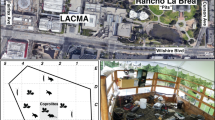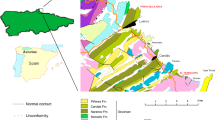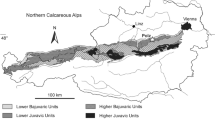Abstract
Fossil faeces (coprolites) provide unique trophic perspectives on ancient ecosystems. Yet, although thousands of coprolites have been discovered, specimens that can be unequivocally attributed to carnivorous dinosaurs are almost unknown. A few fossil faeces have been ascribed to herbivorous dinosaurs1,2,3, but it is more difficult to identify coprolites produced by theropods because other carnivorous taxa coexisted with dinosaurs and most faeces are taxonomically ambiguous. Thus sizeable (up to 20 cm long and 10 cm wide) phosphatic coprolites from Belgium4 and India5,6 that have been attributed to dinosaurs might have been produced by contemporaneous crocodylians7 or fish. But there is no ambiguity about the theropod origin of the Cretaceous coprolite we report here. This specimen is more than twice as large as any previously reported carnivore coprolite, and its great size and temporal and geographic context indicate that it was produced by a tyrannosaur, most likely Tyrannosaurus rex. The specimen contains a high proportion (30–50%) of bone fragments, and is rare tangible evidence of theropod diet and digestive processes.
This is a preview of subscription content, access via your institution
Access options
Subscribe to this journal
Receive 51 print issues and online access
$199.00 per year
only $3.90 per issue
Buy this article
- Purchase on Springer Link
- Instant access to full article PDF
Prices may be subject to local taxes which are calculated during checkout



Similar content being viewed by others
References
Hill, C. R. Coprolites of Ptiliophyllum cuticles from the Middle Jurassic of North Yorkshire. Bull. Br. Mus. Nat. Hist. 27, 289–294 (1976).
Chin, K. 7amp; Gill, B. D. Dinosaurs, dung beetles, and conifers: participants in a Cretaceous food web. Palaios 11, 280–285 (1996).
Chin, K. 7amp; Kirkland, J. I. Probable herbivore coprolites from the Upper Jurassic Mygatt-Moore Quarry, Western Colorado. Mod. Geol. 23, 249–276 (1998).
Bertrand, C. E. Les Coprolithes de Bernissart. I. partie: Les Coprolithes qui ont ete attribues aux Iguanodons. Royal Musee Hist. Nat. Belgique Mem. 1, 1–154 (1903).
Matley, C. A. The coprolites of Pijdura, Central Provinces. Geol. Surv. Recs. 74, 535–547 (1939).
Jain, S. L. in Dinosaur Tracks and Traces (eds Gillette, D. D. 7amp; Lockley, M. G.) 99–108 (Cambridge Univ. Press, Cambridge, UK, (1989)).
Abel, O. Diskussion zu den Vorträgen R. Kräusel and F. Versluys. Palaeontologische Zeitschrift 4, 87 (1922).
Tokaryk, T. T. in Canadian Paleontology Conference Field Trip Guidebook No. 6 (ed. McKenzie-McAnally, L.) 34–44 (Geol. Assoc. Canada, St John's, Newfoundland, (1997)).
Hunt, A. P., Chin, K. 7amp; Lockley, M. G. in The Palaeobiology of Trace Fossils (ed. Donovan, S. K.) 221–240 (Wiley, Chichester, (1994)).
Stienstra, P. Sedimentary Petrology, Origin and Mining History of the Phosphate Rocks of Klein Curacao, Curacao and Aruba, Netherlands West Indies No. 130, 207 (Pub. Found. Sci. Res. Caribbean Region, (1991)).
Farlow, J. O., Smith, M. B. 7amp; Robinson, J. M. Body mass, bone “strength indicator”, and cursorial potential of Tyrannosaurus rex. J. Vert. Paleontol. 15, 713–725 (1995).
Peczkis, J. Implications of body-mass estimates for dinosaurs. J. Vert. Paleontol. 14, 520–533 (1994).
Duke, G. E., Jegers, A. A., Loff, G. 7amp; Evanson, O. A. Gastric digestion in some raptors. Comp. Biochem. Physiol. A 50, 649–659 (1975).
Fisher, D. C. Crocodilian scatology, microvertebrate concentrations, and enamel-less teeth. Paleobiology 7, 262–275 (1981).
Andrews, P. Owls, Caves and Fossils 231 (Univ. Chicago Press, Chicago, (1990)).
Denys, C., Fernandez-Jalvo, Y. 7amp; Dauphin, Y. Experimental taphonomy; preliminary results of the digestion of micromammal bones in the laboratory. Comptes Rendus Acad. Sci. 321, 803–809 (1995).
Mellett, J. S. Dinosaurs, mammals and Mesozoic taphonomy. Acta Palaeontol. Pol. 28, 209–213 (1983).
Hunt, A. P. Phanerozoic trends in nonmarine taphonomy: implications for Mesozoic vertebrate taphonomy and paleoecology. Geol. Soc. Am. Abstr. 19, 171 (1987).
Lucas, J. 7amp; Prévôt, L. E. in Taphonomy: Releasing the Data Locked in the Fossil Record (eds Allison, P. A. 7amp; Briggs, D. E. G.) 389–409 (Plenum, New York, (1991)).
de Ricqlès, A. J. in Morphology and Biology of Reptiles (eds Bellairs, A. d'A. 7amp; Cox, C. B.) 123–150 (Academic, London, (1976)).
Reid, R. E. H. Zonal “grown rings” in dinosaurs. Mod. Geol. 15, 19–48 (1990).
Anderson, J. F., Hall-Martin, A. 7amp; Russell, D. A. Long-bone circumference and weight in mammals, birds and dinosaurs. J. Zool. A 207, 53–61 (1985).
Stevens, C. E. 7amp; Hume, I. D. Comparative Physiology of the Vertebrate Digestive System 2nd edn, 400 (Cambridge Univ. Press, Cambridge, UK, (1995)).
Auffenberg, W. The Behavioral Ecology of the Komodo Monitor 406 (Univ. Presses of Florida, Gainesville, (1981)).
Fiorillo, A. R. Prey bone utilization by predatory dinosaurs. Palaeogeogr. Palaeoclimatol. Palaeoecol. 88, 157–166 (1991).
Farlow, J. O. Aconsideration of the trophic dynamics of a Late Cretaceous large-dinosaur community (Oldman Formation). Ecology 57, 841–857 (1976).
Farlow, J. O., Brinkman, D. L., Abler, W. L. 7amp; Currie, P. J. Size shape and serration density of theropod dinosaur lateral teeth. Mod. Geol. 16, 161–198 (1991).
Erickson, G. M. et al. Bite-force estimation for Tyrannosaurus rex from tooth-marked bones. Nature 382, 706–708 (1996).
Erickson, G. M. 7amp; Olson, K. H. Bite marks attributable to Tyrannosaurus rex: preliminary description and implications. J. Vert. Paleontol. 16, 175–178 (1996).
Hooper, P. R., Johnson, D. M. 7amp; Conrey, R. M. Major and trace element analyses of rocks and minerals by automated X-ray spectrometry (Washington State Univ., Geol. Dept, Open File Report, (1993)).
Acknowledgements
We thank W. Sloboda for the discovery of the coprolite; the Allemand family for permitting access to the land and its fossils; H. N. Bryant, M. J. Jurashius, C. E. Meyer, M. Moreno, R. L. Oscarson, J. F. Parham, D. Pierce, J. Rifkin and B. H. Tiffney for comments and technical assistance; the Royal Saskatchewan Museum, Stanford University, the US Geological Survey, and the University of California at Santa Barbara for technical and administrative assistance; and the late W. V. Sliter for support and encouragement.
Author information
Authors and Affiliations
Corresponding author
Rights and permissions
About this article
Cite this article
Chin, K., Tokaryk, T., Erickson, G. et al. A king-sized theropod coprolite. Nature 393, 680–682 (1998). https://doi.org/10.1038/31461
Received:
Accepted:
Issue Date:
DOI: https://doi.org/10.1038/31461
This article is cited by
-
Intestinal preservation in a birdlike dinosaur supports conservatism in digestive canal evolution among theropods
Scientific Reports (2022)
-
The Tyrant Lizard King, Queen and Emperor: Multiple Lines of Morphological and Stratigraphic Evidence Support Subtle Evolution and Probable Speciation Within the North American Genus Tyrannosaurus
Evolutionary Biology (2022)
-
Tyrannosaurid-like osteophagy by a Triassic archosaur
Scientific Reports (2019)
-
Regurgitated ammonoid remains from the latest Devonian of Morocco
Swiss Journal of Palaeontology (2019)
-
Exceptional dinosaur fossils reveal early origin of avian-style digestion
Scientific Reports (2018)
Comments
By submitting a comment you agree to abide by our Terms and Community Guidelines. If you find something abusive or that does not comply with our terms or guidelines please flag it as inappropriate.



